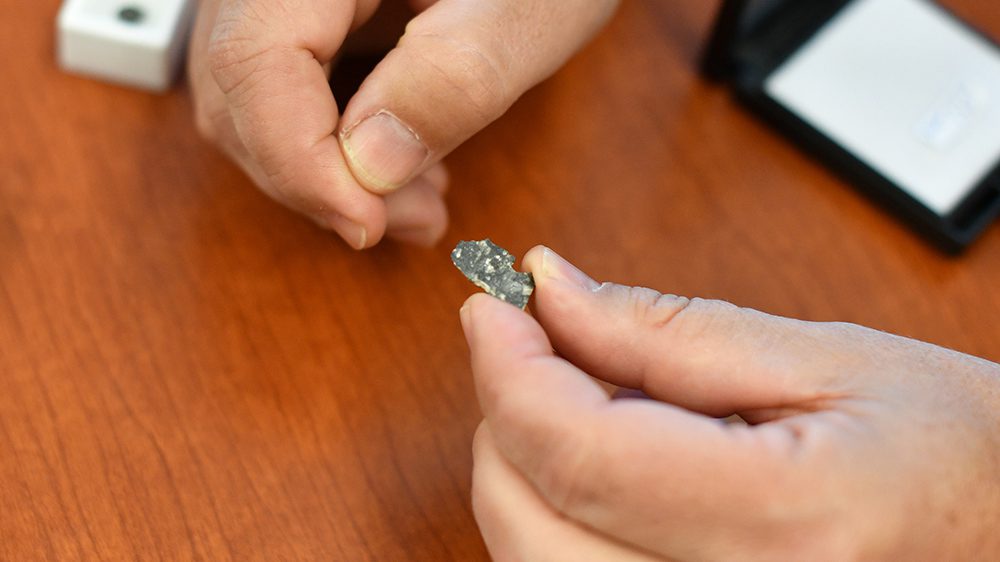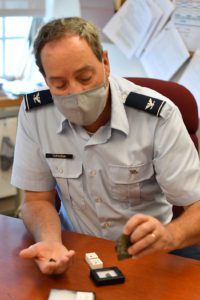‘Older Than the Earth Itself’ Meteorite Collection Gifted to VMI by Alumnus

The meteorite fragments recently donated by Paulo Rocha ‘87 range from 4.5 million to 7 billion years old.—VMI Photo by Kelly Nye.

The meteorite fragments recently donated by Paulo Rocha ‘87 range from 4.5 million to 7 billion years old.—VMI Photo by Kelly Nye.
It’s a pretty safe bet to say that the chances of anyone ever donating something to VMI that’s more than 7 billion years old are, well, astronomical.
And it’s certainly not every day that something older than the Earth itself arrives on post via the U.S. mail. But that’s exactly what’s happened this fall when stargazer and Army veteran Paulo Rocha, Class of 1987, donated a collection of 11 meteorites to the Department of Physics and Astronomy.
“I have a love for meteorites and decided to share that passion with the Institute in hopes other cadets will also enjoy the experience,” Rocha wrote in an email.
Collectors can scour the Earth, of course, looking for fragments of these objects from outer space, but like nearly everything else these days, meteorite pieces are for sale online. That’s where Rocha bought the meteorites he donated to VMI, after a careful screening of his sources to make sure he wasn’t paying hundreds of dollars for a very terrestrial rock.
“Not everything that is on sale is the real thing, so one has to be careful,” he commented. “The certified sellers are usually members of the International Meteorite Collectors Association.”
Col. Greg Topasna, Ph.D., who teaches VMI’s astronomy courses, was thrilled when Col. Tim Hodges, Ph.D., Class of 1980, department chair, told him that there was an alumnus willing to donate meteorites to VMI.

Col. Greg Topasna, Ph.D., professor of physics, examines one of the lunar meteorites recently donated to VMI. Topasna holds one of the few Peay chairs at VMI.—VMI Photo by Kelly Nye.
“I’ve always wanted VMI to have a collection of meteorites, but you find other things to spend money on,” he noted. Before Rocha’s gift arrived this fall, VMI owned one meteorite—not exactly a collection—and Topasna doesn’t know its origin, as it was left behind by Col. Dave Dupuy when he retired.
The meteorites from Rocha’s collection are incredibly varied. The oldest is a very tiny piece of the famous Murchison meteorite, which fell to Earth in Australia in 1969. Scientists have dated the silicon carbide particles in the meteorite at 7 billion years, making the Murchison meteorite the oldest known object on the planet—and, in fact, 2.5 billion years older than the Earth itself.
As they ever-so-carefully pass around the tiny shard of meteorite, Topasna tells cadets, “This is the oldest thing you’ll ever hold in your hand. This is a piece of the solar nebula from before we were even here.”
But the Murchison meteorite is much more than an iron-containing rock that just happened to survive its fall from space. It’s been found to contain amino acids, the building blocks of life. That makes it a perfect fit for discussion in Topasna’s astrobiology class, in which cadets wrestle with questions such as how life is defined, how life might be discovered via signals from outer space, and perhaps most tantalizingly, must life be defined as carbon-based? Might silicon-based life forms exist as well?
“It’s a really good question,” said Topasna. “We can’t rule it out, but there are reasons carbon wins out over silicon. … It’s a fun course.”
The other meteorites from Rocha’s collection are much younger than the Murchison meteorite—but in this case, “younger” is a relative term. Most meteorites are approximately 4.5 million years old. In the majority of cases, the true origin is unknown, but three from Rocha’s donation are known to be from the moon and one is from Mars. They’ve been collected all over the planet, including Russia, Argentina, and Northwest Africa.
This fall, Topasna is interested in showing the meteorites to cadets in his classes and using them as a teaching tool. Down the road, he hopes to place the collection in a display case so anyone passing by might stop and take a look, and so Rocha can be thanked in a public way.
“It makes a nice learning opportunity for the cadets,” said Topasna. “This is a wonderful gift.”